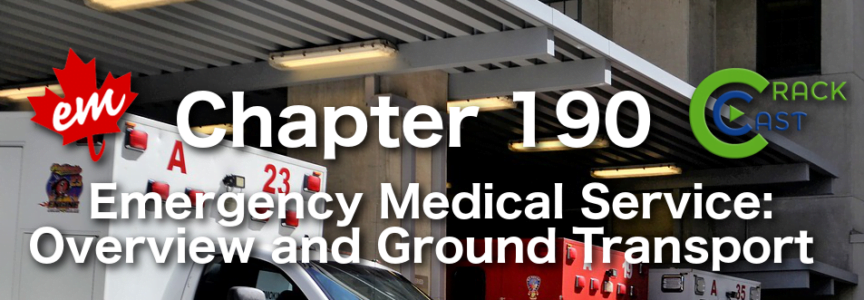This episode of CRACKCast covers Chapter 190 of Rosen’s Emergency Medicine(9th Ed.). After listening to this podcast, you will have a more comprehensive understanding of the intricacies of pre-hospital care and be better able to address issues in your community’s out-of-hospital healthcare network.
Shownotes – PDF HERE
[bg_faq_start]Rosen’s In Perspective:
If you like history, read the first few pages of the chapter. It discusses how EMS started!
There are multiple sub-categorizations of EMS systems: private and public agencies; basic life support (BLS) and advanced life support (ALS) services; single-tiered, multitiered, and first responder systems. We won’t cover any of these things in detail, but they do exist.
But, what’s the role of physicians in EMS?
- Medical direction: providing delegation and protocols
- Medical educator: training, certification, institution
- Participation as an EMS provider: via air medical transport or transport teams
- Quality assurance: feedback to EMS providers
- Patient advocate: optimizing patient care
- Medical control: offline and online
- Research
[1] What are the components of an EMS system
NOTE: This is not an exhaustive list; we tried to organize it from the “top” down.
- Federal and local government
- Funding models: public vs. private
- Governing body / state or provincial office
- Assist in licensing, planning, establishing and enforcing scopes and standards of practice
- Training, examining, certifying, record-keeping; data collection; and auditing or investigating programs
- Administrative office
- Fee collection
- Logistics
- Finances
- Operations
- Public information and on-field communication program (calling 911 in North America)
- Including field communication between paramedics and hospital staff for pre-arrival notification
- Dispatching system
- Catchment area
- Call prioritization
- Management of available resources
- Protocols for improving on-scene care before EMS arrival
- Opening and clearing an airway, performing CPR, controlling haemorrhage, and assisting with childbirth
- Education programming for telecommunicators
- Quality improvement processes
- Transportation / facilities
- Medical direction / medical oversight board
- Offline vs. online medical control
- First responders (police / firefighters)
- BLS / ALS providers
NOTE: In a single-tiered system, every response regardless of the call type receives the same level of personnel expertise and equipment allocation (all BLS or ALS). Multiple-tiered systems use a combination of ALS and BLS levels, depending on the nature of the call.
NOTE: Differences in cost and effectiveness between a mixed ALS-BLS service and an all-ALS service have been debated.
NOTE: The Boyd Model lists 15 components that are essential to a functional EMS system. These include: manpower, training, communications, transportation, facilities/critical care units, public safety agencies, consumer participation, access to care, transfer of care, standard patient record, public information and education, independent review and evaluation, disaster linkage, and mutual aid agreements
[2] What is the role of the EMS medical director? What is offline vs online medical control?
ANSWER: An EMS medical director is a physician with a specialized interest and knowledge of patient care activities unique to the out-of-hospital environment. Medical oversight must extend from the communications centre through all components of field care.
Offline Medical Control | Online Medical Control – may be centralized or decentralized |
|
|
NOTE: Personnel responsible for direct medical control must be knowledgeable about the entire EMS system, receiving facilities, protocols, medication formulary and equipment, administrative and operational issues, and medical-legal implications for certain presenting situations. Systems whose protocols include standing orders may require direct communication only for specific reasons. Thus, whereas these medical and administrative protocols may guide EMTs through most circumstances, medical control consultation may assist with medical-legal issues, problems at the scene, patient non-transport, or ethical dilemmas that may be encountered. Furthermore, direct medical control is usually invaluable for notification and staff preparation when critical or potentially critical patients are being transported.
[3] How are rural and urban EMS systems different?
- Huge variability of staffing levels
- Volunteers, EMR, EMT/PCPs, and paramedics
- Long transport times to hospitals in rural centres
- Extreme environments (think about the Canadian shield or a rural winter setting) in rural centres
- Trauma is over-represented in rural areas
- “70% of trauma deaths occur in rural environments, despite a small percentage of the Canadian population living there”
- Over half of all serious MVCs are seen at non-trauma centres
- Community involvement is crucial (witnesses, bystanders)in rural centres
- Variable standards of care in rural centres, as it is difficult to ensure skill retention in low-volume settings
[4] Describe the basic skill set of first responders/EMR’s, paramedics, and advanced paramedics.
For a more comprehensive explanation of EMS levels of training and scopes of practice, please refer to Table 190.1 in Rosen’s 9th Edition.
- First Responder or EMR
- Individual with either BLS or ALS who responds to calls to provide care initially until more definitive treatment is available or transport services arrive
- Typically, first responders are police officers or firefighters
- These individuals are able to perform CPR, provide basic airway management, control haemorrhages, immobilize patients with suspected or potential spinal injury, and use AED’s
- EMT – B (also known as PCP, EMT, or EMT-Ambulance)
- Has the same skill set as a first responder, but also can triage, participate in more detailed patient assessments and aid in transport
- Some can initiate IV’s in certain jurisdictions
- EMT- I ACP
- Scope varies for these persons
- In most EMS systems, ACP’s are able to initiate IV’s, use defibrillators (automatic or semiautomatic), use limited advanced airway devices, and administer some medications
- EMT-P CPC
- These are the most advanced prehospital care providers
- These individuals are able to defibrillate and intubate, perform needle decompression, surgical cricothyrotomy, and transthoracic cardiac pacing
- These providers also are able to administer many medications
NOTE: Some medications that may be administered by PCPs:
- Epinephrine
- Naloxone
- Dimenhydrinate
- Salbutamol
- Nitroglycerin
More and more, we see a change to have paramedics work as community support workers helping the general public stay at home. Programs that facilitate this are designed to diminish the need for EMS calls and to diminish ED utilization for certain patients or individuals who frequently use EMS services. These individuals can participate in:
- Working in the roles of a community health worker
- Wound care providers (including suturing)
- Falls prevention
- CHF / COPD care
- Mass education
- Search and rescue
- Tactical EMS
- Hazmat
[5] What basic, clinically proven prehospital interventions can be provided by EMS providers in relation to:
- Cardiac Emergencies
- AED/Defibrillation for ventricular tachyarrhythmias
- Excellent CPR for sudden cardiac death
- Acquisition and transmission of out-of-hospital 12-lead ECG
- Possible benefits:
- ASA
- Nitro
- Trauma
- Airway control
- Jaw thrust, OPA/NPA, EGD, (Intubation in a prehospital environment hasn’t been proven as beneficial in severely injured patients)
- Stop haemorrhage
- Direct pressure, dressings, tourniquet, pelvic binder
- Splinting / stabilization of bony injuries
- Shock
- Epinephrine IM for anaphylaxis
- Respiratory emergencies
- Salbutamol for bronchospasm
- Drug overdoses
- Narcan administration
- Hypoglycaemia
- D50/glucagon
- Seizures
- Benzodiazepines
[6] How can a physician handle the patient refusing to be transported to hospital?
ANSWER: This is a complex decision. Largely, you need to make a decision based on a number of factors. These factors are discussed below:
- Your ability to communicate with the patient
- THIS IS AN EXTREMELY DIFFICULT THING TO DO OVER THE PHONE!
- Can they speak English?
- Do you have a good telephone connection?
- Do you have a call-back number in case you get cut off?
- Does the patient out rightly refuse to communicate with you and undergo a capacity assessment?
- Does the patient have the capacity to refuse medical care?
- Elements of assessing capacity: Does this person possess the mental ability to make an informed decision?
- Understanding the situation
- Expressing a choice
- Why do they want to refuse care?
- Appreciation of how the information applies to oneself
- The problem
- The options
- Reasoning
- Does their reasoning coincide with their stated values and beliefs?
NOTE: In the presence of cognitive impairment, determining whether a patient has adequate capacity is critical to striking the proper balance between respecting patient autonomy and acting in a patient’s best interest. – Uptodate
Also CONSIDER:
- Degree of patient autonomy vs. public duty to act as a Good Samaritan?
- What are some of your local social and cultural norms?
- What are some of the family’s values and preferences?
- Availability of reasonable alternatives?
- Is the patient willing to call a friend, and go to the hospital later in the day?
- Can they see their own family doctor?
- Principles of ethics:
- Autonomy
- Acting in a person’s best interests
- Beneficence
- Nonmaleficence
- Justice
NOTE: The degree and urgency with which to act on findings of impaired capacity depends on multiple factors, including the expected duration of impairment, the severity of the impairment, and the seriousness of the decision. For patients whose impairments are severe enough that they are judged to lack the capacity to make a decision, there is a clear ethical obligation to seek out a substitute decision maker. – Uptodate
To recap, here are the issues:
- Communication
- Define the problem – why do they want to refuse care?
- Capacity assessment
- Patient autonomy vs. public duty
- Alternatives
- Informed decision-making
- Documentation explanation and recording
- Offer of help at any time in the future
[7] How to determine termination of resuscitation in the field?
ANSWER: Another complex decision which depends on YOUR local EMS policies and whether or not you have off-line vs. on-line medical control.
Here are a few “safe” reasons to terminate resuscitation:
- An unwitnessed cardiopulmonary arrest with no bystander CPR
- No ROSC despite CPR
- A decomposing, decapitated, rigor mortised, or frozen person
- Continuing resuscitation would place the care providers at an unsafe level of risk of death or disability
- The discovery of an advanced care directive stating the patient would not want CPR
- Physician judgement
NOTE: As per Uptodate, the OPALS study group has proposed two termination of resuscitation rules for use by EMS personnel. The rule for BLS providers equipped with AEDs includes the following three criteria:
- Event not witnessed by emergency medical services personnel
- No AED used, or manual shock applied in out-of-hospital setting
- No return of spontaneous circulation in out-of-hospital setting.
NOTE: The advanced life support (ALS) rule includes the BLS criteria as well as two additional criteria:
- Arrest not witnessed by bystander and
- No bystander-administered CPR
In the studies, the BLS rule is cited with a 98.7% specificity; the ALS rule has a 100% specificity.
[8] How to handle a “physician” on scene?
This is a scenario that could go either way – to harm the patient or to help. But, I’m sure most paramedics are super frustrated when someone tries to “help” them and actually gets in the way.
A few issues:
- Is this person actually a physician? (do they have ID and an up-to-date license)
- Is this doctor actually qualified, and are they the most appropriate person to help?
- For example, a psychiatrist offering to help intubate on the scene of an accident
- Will they delay transfer to definitive care?
- Is this physician trying to deviate from standard protocols or guidelines?
- Is this physician willing to communicate with online medical control?
- Will the physician accept responsibility and accompany the patient to the hospital?
NOTE: If a physician assists with treatment that conforms to EMS protocols, they are not required to accompany patient to hospital
[bg_faq_end]This post was reviewed and copyedited by Dillan Radomske (@DillanRadomske)


